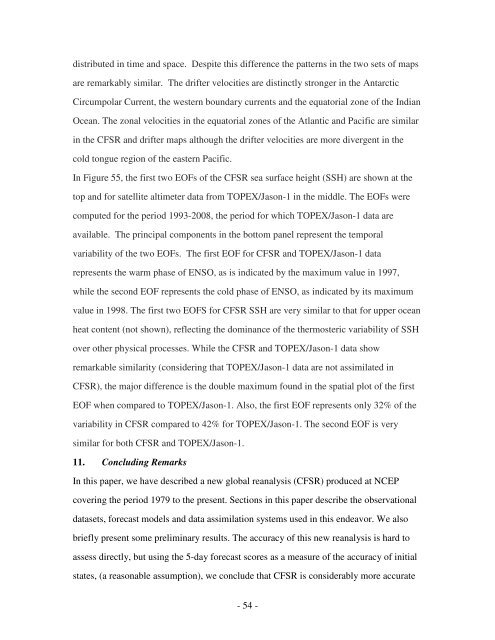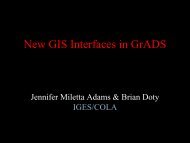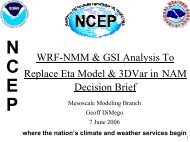The NCEP Climate Forecast System Reanalysis - NOAA National ...
The NCEP Climate Forecast System Reanalysis - NOAA National ...
The NCEP Climate Forecast System Reanalysis - NOAA National ...
You also want an ePaper? Increase the reach of your titles
YUMPU automatically turns print PDFs into web optimized ePapers that Google loves.
distributed in time and space. Despite this difference the patterns in the two sets of mapsare remarkably similar. <strong>The</strong> drifter velocities are distinctly stronger in the AntarcticCircumpolar Current, the western boundary currents and the equatorial zone of the IndianOcean. <strong>The</strong> zonal velocities in the equatorial zones of the Atlantic and Pacific are similarin the CFSR and drifter maps although the drifter velocities are more divergent in thecold tongue region of the eastern Pacific.In Figure 55, the first two EOFs of the CFSR sea surface height (SSH) are shown at thetop and for satellite altimeter data from TOPEX/Jason-1 in the middle. <strong>The</strong> EOFs werecomputed for the period 1993-2008, the period for which TOPEX/Jason-1 data areavailable. <strong>The</strong> principal components in the bottom panel represent the temporalvariability of the two EOFs. <strong>The</strong> first EOF for CFSR and TOPEX/Jason-1 datarepresents the warm phase of ENSO, as is indicated by the maximum value in 1997,while the second EOF represents the cold phase of ENSO, as indicated by its maximumvalue in 1998. <strong>The</strong> first two EOFS for CFSR SSH are very similar to that for upper oceanheat content (not shown), reflecting the dominance of the thermosteric variability of SSHover other physical processes. While the CFSR and TOPEX/Jason-1 data showremarkable similarity (considering that TOPEX/Jason-1 data are not assimilated inCFSR), the major difference is the double maximum found in the spatial plot of the firstEOF when compared to TOPEX/Jason-1. Also, the first EOF represents only 32% of thevariability in CFSR compared to 42% for TOPEX/Jason-1. <strong>The</strong> second EOF is verysimilar for both CFSR and TOPEX/Jason-1.11. Concluding RemarksIn this paper, we have described a new global reanalysis (CFSR) produced at <strong>NCEP</strong>covering the period 1979 to the present. Sections in this paper describe the observationaldatasets, forecast models and data assimilation systems used in this endeavor. We alsobriefly present some preliminary results. <strong>The</strong> accuracy of this new reanalysis is hard toassess directly, but using the 5-day forecast scores as a measure of the accuracy of initialstates, (a reasonable assumption), we conclude that CFSR is considerably more accurate- 54 -





